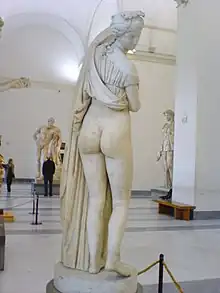Carlo Albacini
Carlo Albacini (1734 — 1813[2]) was an Italian sculptor and restorer of Ancient Roman sculpture.
_02.jpg.webp)
He was a pupil of Bartolomeo Cavaceppi, an eminent sculptor and restorer of Rome. Albacini was notable for his copies after classical originals such as the Farnese Hercules; his version of the Castor and Pollux at the Prado is now in the Hermitage Museum[3]) or the Capitoline Flora from Hadrian's Villa,[4] for the Grand Tourist market. Like Cavaceppi, he also restored classical sculptures, notably the Farnese marbles, which Albacini worked on in 1786-89, in preparation for their transfer to Naples under the direction of the German painter Hackert and Domenico Venuti.[5] Some of his restorations were free, by modern standards: in the famous Farnese Aphrodite Kallipygos at Naples, the head, the exposed right breast, left arm and right leg below the knee are restorations by Albacini.[6] Not restored in Rome before shipment to Naples, however, were the Farnese paired Tyrannicides restored as Gladiators.[7] Albacini was the principal restorer for Thomas Jenkins, whose pre-eminent client was Charles Townley; Townley's collection is at the British Museum. Townley introduced Albacini to Henry Blundell whose collection of Roman sculptures was magnificently displayed at Ince Blundell.[8] In 1776 Blundell, considering that a fine modern copy was superior to a mediocre antiquity, commissioned from Albacini a copy of a colossal marble head of Lucius Verus;[9] when the young Antonio Canova visited the workshops of Cavaceppi and of Albacini in 1779-80, he spoke to one of Albacini's garzonieri who said he had already spent fourteen months pointing up a copy of the Borghese bust of Lucius Verus and had five months of work still to do.[10]

He catalogued the immense collection of antique sculpture, some of its freely restored, left by Cavaceppi,[11] and he assembled the collection of casts of Greco-Roman portrait busts that was sold by Filippo Albacini and can be seen in the Capitoline Museums, the Vatican Museums, in Naples, and at the Prado and Casa del Labrador, Aranjuez,[12] the Real Academia de Bellas Artes de San Fernando,[13] and especially at the National Gallery of Scotland, where the presence of a large group of plaster casts purchased from Albacini's son in 1838 was the subject of a colloquium on the varying reputation and cultural significance of casts of classical sculptures and the varying parameters of ethical restorations.[14]
On a smaller scale his workshop, working with Luigi Valadier, produced the elaborate table-setting in gilded and patinated bronze and rare coloured marbles on the Romantic-Classical theme The Ruins of Paestum that was designed for Maria Carolina by Domenico Venuti, 1805.[15]
As marble masons, Albacini's workshop also executed architectural sculptures, such as the two simple chimneypieces of white and coloured marble for the gallery of Ferdinand IV of Naples' hunting box, the Casino Reale at Carditello,[16] about 14 km northeast of Naples. Pedestals for sculpture, for which Albacini was to be paid, were shipped from Livorno in 1780 by Gavin Hamilton intended for Thomas Pitt, later Lord Camelford, who did not take them.[17]
His son, also Carlo Albacini (1777 – 1858), was a sculptor.
Some other sculptors in Rome renowned for their restorations
Notes
- Fernando, Real Academia de BBAA de San. "Albacini, Carlo - Amazona". Academia Colecciones (in Spanish). Retrieved 5 January 2021.
- "Scultura Archivi - Carlo Virgilio & C".
- Hermitage Castor and Pollux.
- A half-size copy is conserved in the Indianapolis Museum of Art; it was included in the exhibition The Splendor of Eighteenth-Century Rome, Philadelphia and Houston, 2000.
- Alvar González-Palacios, "The Furnishing of the King of Naples's Hunting Lodge at Carditello", The Burlington Magazine 146No. 1219, Art in Italy: Discoveries and Attributions (October 2004:683-690) pp 683.
- Gösta Säflund, Peter M. Fraser, tr. Aphrodite Kallipygos, Stockholm, 1963.
- Illustrated by Howard 1993 pl. 38c, as restored by Albacini, but see Andrew Stewart, "David's 'Oath of the Horatii' and the Tyrannicides" The Burlington Magazine 143 No. 1177 (April 2001: 212-219) p. 216 note 9.
- Gerard Vaughan, in Davies 1991.
- Jane Fejfer, The Ince Blundell Collection of Classical Sculpture 2: The Roman Male Portraits, 1997
- Hugh Honour, "Canova's Studio Practice-I: The Early Years", The Burlington Magazine 114No. 828 (March 1972:146-159) p.153, noting Canova's Quaderni di viaggio.
- Seymour Howard, "Some Eighteenth-Century 'Restored' Boxer", Journal of the Warburg and Courtauld Institutes 56 (1993;238-255) p. 243.
- Seymour Howard, "Ancient busts and the Cavaceppi and Albacini casts", Journal of the History of Collections 3 (1991:199-217); Glenys Davies, "The Albacini Cast Collection - Character and significance", Journal of the History of Collections 1991 32:145-165.
- Fernando, Real Academia de BBAA de San. "Albacini, Carlo". Academia Colecciones (in Spanish). Retrieved 5 January 2021.
- Glenys Davies, ed. Plaster and Marble: the Classical and Neo-Classical Portrait Bust (the Edinburgh Albacini Colloquium), Journal of the History of Collections 3, (Oxford University Press) 1991.
- Alvar González-Palacios, Il gusto dei principi: arte del corto nel xvii e xviii secoli1993.
- González-Palacios 2004:683, illus. p. 686 ; González-Palacios notes that the two chimneypieces in question were stolen from storage in 2002.
- Brendan Cassidy, "Gavin Hamilton, Thomas Pitt and Statues for Stowe" The Burlington Magazine 146 No. 1221 (December 2004:806-814) p. 809.
External links
- Carlo Albacini on artnet.com